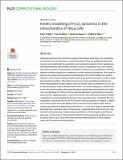Kinetic modeling of H2O2 dynamics in the mitochondria of HeLa cells
Author(s)
Stein, Kassi T; Moon, Sun Jin; Nguyen, Athena N; Sikes, Hadley D
DownloadPublished version (2.573Mb)
Publisher with Creative Commons License
Publisher with Creative Commons License
Creative Commons Attribution
Terms of use
Metadata
Show full item recordAbstract
© 2020 Stein et al. This is an open access article distributed under the terms of the Creative Commons Attribution License, which permits unrestricted use, distribution, and reproduction in any medium, provided the original author and source are credited. Hydrogen peroxide (H2O2) promotes a range of phenotypes depending on its intracellular concentration and dosing kinetics, including cell death. While this qualitative relationship has been well established, the quantitative and mechanistic aspects of H2O2 signaling are still being elucidated. Mitochondria, a putative source of intracellular H2O2, have recently been demonstrated to be particularly vulnerable to localized H2O2 perturbations, eliciting a dramatic cell death response in comparison to similar cytosolic perturbations. We sought to improve our dynamic and mechanistic understanding of the mitochondrial H2O2 reaction network in HeLa cells by creating a kinetic model of this system and using it to explore basal and perturbed conditions. The model uses the most current quantitative proteomic and kinetic data available to predict reaction rates and steady-state concentrations of H2O2 and its reaction partners within individual mitochondria. Time scales ranging from milliseconds to one hour were simulated. We predict that basal, steady-state mitochondrial H2O2 will be in the low nM range (2-4 nM) and will be inversely dependent on the total pool of peroxiredoxin-3 (Prx3). Neglecting efflux of H2O2 to the cytosol, the mitochondrial reaction network is expected to control perturbations well up to H2O2 generation rates ~50 μM/s (0.25 nmol/ mg-protein/s), above which point the Prx3 system would be expected to collapse. Comparison of these results with redox Western blots of Prx3 and Prx2 oxidation states demonstrated reasonable trend agreement at short times (≤ 15 min) for a range of experimentally perturbed H2O2 generation rates. At longer times, substantial efflux of H2O2 from the mitochondria to the cytosol was evidenced by peroxiredoxin-2 (Prx2) oxidation, and Prx3 collapse was not observed. A refined model using Monte Carlo parameter sampling was used to explore rates of H2O2 efflux that could reconcile model predictions of Prx3 oxidation states with the experimental observations.
Date issued
2020Department
Massachusetts Institute of Technology. Department of Chemical Engineering; Massachusetts Institute of Technology. Department of Biological EngineeringJournal
PLoS Computational Biology
Publisher
Public Library of Science (PLoS)